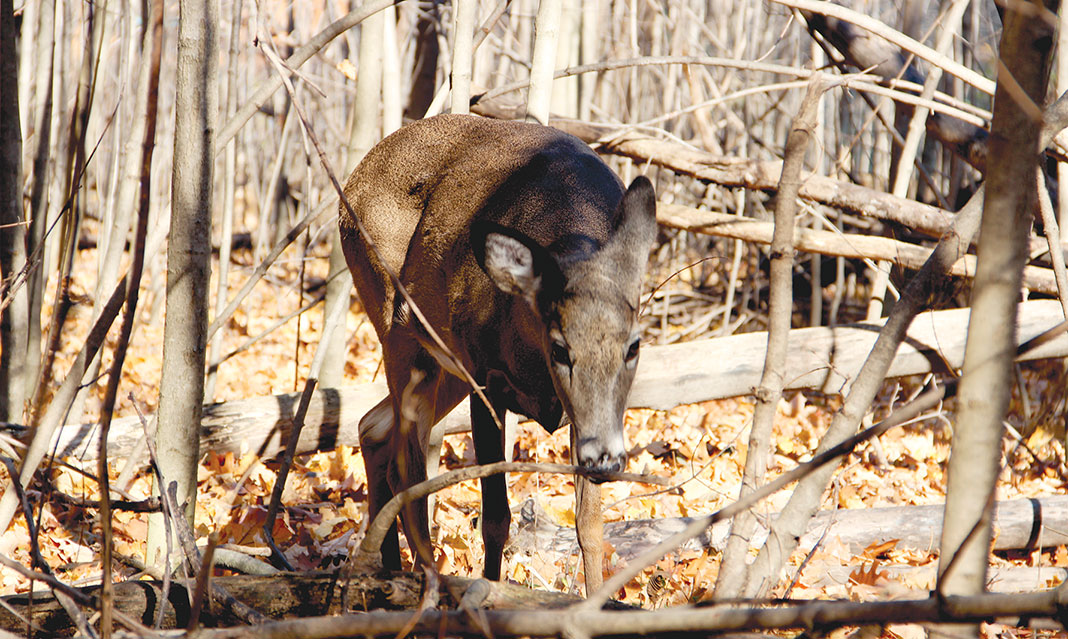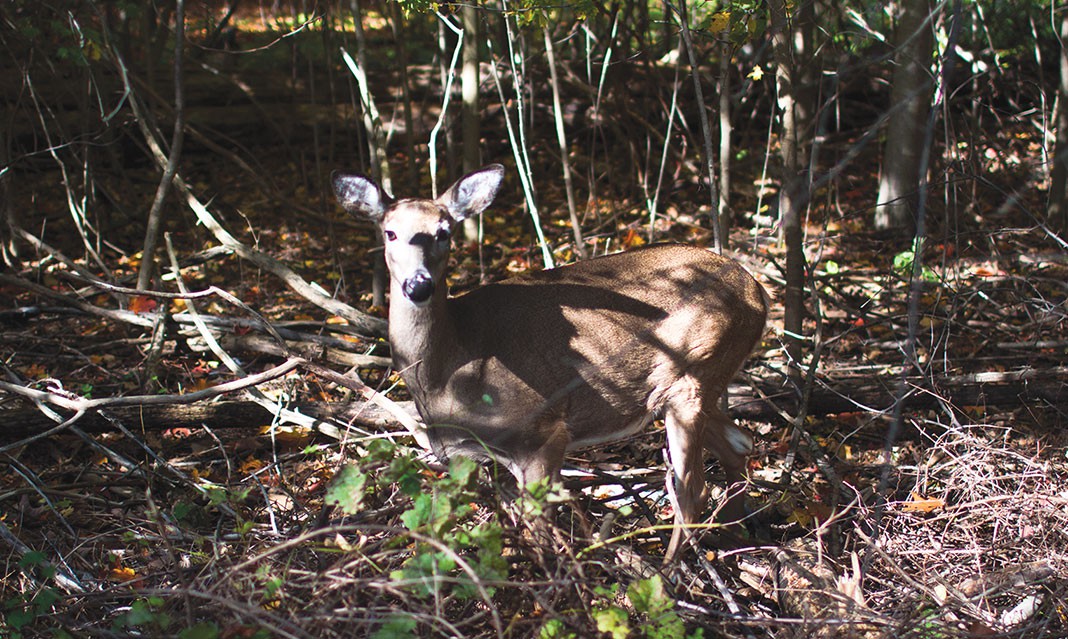If there’s one thing that we’re proud of here at UTM, it’s our beloved deer population. From Deerfield Hall to the crowds that appear every single time a deer-sighting occurs, it’s a wonder that there isn’t already a course dedicated to the deer on campus (although there is a Twitter account for them). However, Bansari Patel and Jonathan Branco can now say otherwise—they had the chance to follow deer and observe them around the UTM campus as a part of their summer research project. Stalking deer and doing coursework at the same time? Sign me up!
The two students investigated the effect of white-tailed deer foraging on UTM’s plant community. This project, under the supervision of professors Monika Havelka and Christoph Richter, was the first of its kind—a pilot study dedicated to white-tailed deer. Their summer research project occurred through the Research Opportunity Program.
Patel, a third-year student with a double major in biology and environmental studies, was not originally assigned to this research project. “I had applied for a ROP about swallows and sparrows,” she says. However, when her supervisor, Havelka, offered her the unique opportunity to observe deer in their natural habitat, she said yes—and never looked back.
On the other hand, Branco is an exchange student from the Brazilian University of Sao Paulo. He is a third-year biology major and has been at UTM since July 2014. “My original project was to study alligators,” he says. That project was cancelled due to a few complications, but Branco was more than happy to take on a research project dedicated to deer.
For their fieldwork, the two students would head out early in the morning three times a week to find and follow deer around the UTM campus. “We followed the deer for as long as we didn’t lose it,” says Patel. When asked how often they lost deer, Patel laughed. Clearly our deer population is stealthier than we give them credit for.
Given that these two students followed the deer around for about four months, they have several observations to offer. According to the two deer enthusiasts, only white-tailed deer (Odocoileus virginianus) are present on the UTM campus.
Branco said that the most common areas to observe deer were the five-minute walk and around the front of IB, CCT (towards the forest area), and the residence buildings around Erindale Hall.
“Deer love the cloudy and rainy days. They tried to avoid the sun,” adds Patel. “When it was gloomy or cloudy, we would see them out until 11 or 12—they’re usually not out that late. Usually 9 at the most.”
The two students observed that while male deer tend to be solitary, female deer tend to stick together, especially around their fawns.
The difference between a doe and a buck is simply the presence of antlers. Does don’t have antlers at all. And while male deer do have antlers, they tend to shed them every alternate year and have scarring along that area.
“Sometimes the deer didn’t mind [that we were following them],” says Patel. “If they were fawns, we were extra careful and stayed away from them.” Patel explained that while young fawns are easily recognizable due to their smaller size, they are also distinguished by the white spots on their backs. “When they grow up, the spots go away.”
“Sometimes [the deer] did care, and we had to use binoculars to observe which plants the deer were browsing,” says Branco.
However, this pilot study wasn’t all about following deer around—the students were leading a threefold study. Their first aim was to investigate the effect of white-tailed deer browsing (i.e. feeding) on UTM’s plant community.
“At first, it was really hard to identify plants that were being browsed by the deer,” says Branco. “We took pictures and some samples [to help with identification].” They then learned how to identify the plants being eaten with the help of reference textbooks and faculty members such as biology professor Peter Kotanen.
“If deer browse on leaves, it’s been chewed off. Threads of the plant are still there,” says Patel. “But if it’s a blunt cut and it’s lower, nearer to the ground, then it’s a rabbit.” Branco added that identifying browsing signs was definitely not a precise science, but through fieldwork and observing deer, they believe that they have collected sufficient samples to carry out their project successfully.
Within a few weeks of observing deer, Patel and Branco noticed that deer don’t enjoy eating garlic mustard—in fact, the deer tended to avoid this particular plant repeatedly. Garlic mustard is actually an invasive plant species, so it led the two to wonder: since garlic mustard is rarely eaten by deer, do plants surrounding this invasive species benefit greatly from the presence of garlic mustard? As of right now, the two don’t have a conclusive answer to this question, but fear not—they plan to continue collecting evidence to find the answer.

Aside from the deer not enjoying garlic mustard, it seems that our favourite animals don’t enjoy fern either. On the other hand, the whitetails enjoy feeding on maples (Acer sp.), the Virginia creepers (Parthenocissus quinquefolia), and grapes (Vinus spp.).
Patel and Branco were also responsible for preparing the necessary paperwork and seeking permission to set up exclosures at the Riverwood Conservancy. Exclosures are simply a small area of land that intend to keep out browsing animals—in this case, the plan was to observe plant diversity and composition on a small area (nine square metres) in both the presence and absence of deer. One exclosure will be fenced off by a six-foot high fence to prevent browsers—most notably deer—from entering. The second exclosure is to be open to all animals.
“[With the exclosures], we want to see how [browsing] would affect the community, and how it would cause a shift in biodiversity and [the] composition of the plants,” says Patel. “Right now certain plants are more dominant than the others—what effect will being browsed over and over again have [on their numbers]?”
The two students are still waiting for the paperwork to be completed before they start this phase of their project.
The exclosures will be a long-term project. “They need to be up for at least four to six years in order for them to be meaningful,” explains Branco. “We are also putting cameras up so that we can observe and identify deer [who approach the exclosures].”
Both students agree that the highlight of the research project was when they came across young fawns. “Early morning, the babies would be playing and jumping around,” says Patel. “The best part was when we found seven deer around. They were all resting around the CCT/library link.” According to the two students, three fawns were born this past summer.
Sadly, Branco will be returning to Brazil next week. On the other hand, Patel is excited to continue the research project and looks forward to learning (and stalking) more deer this year.



